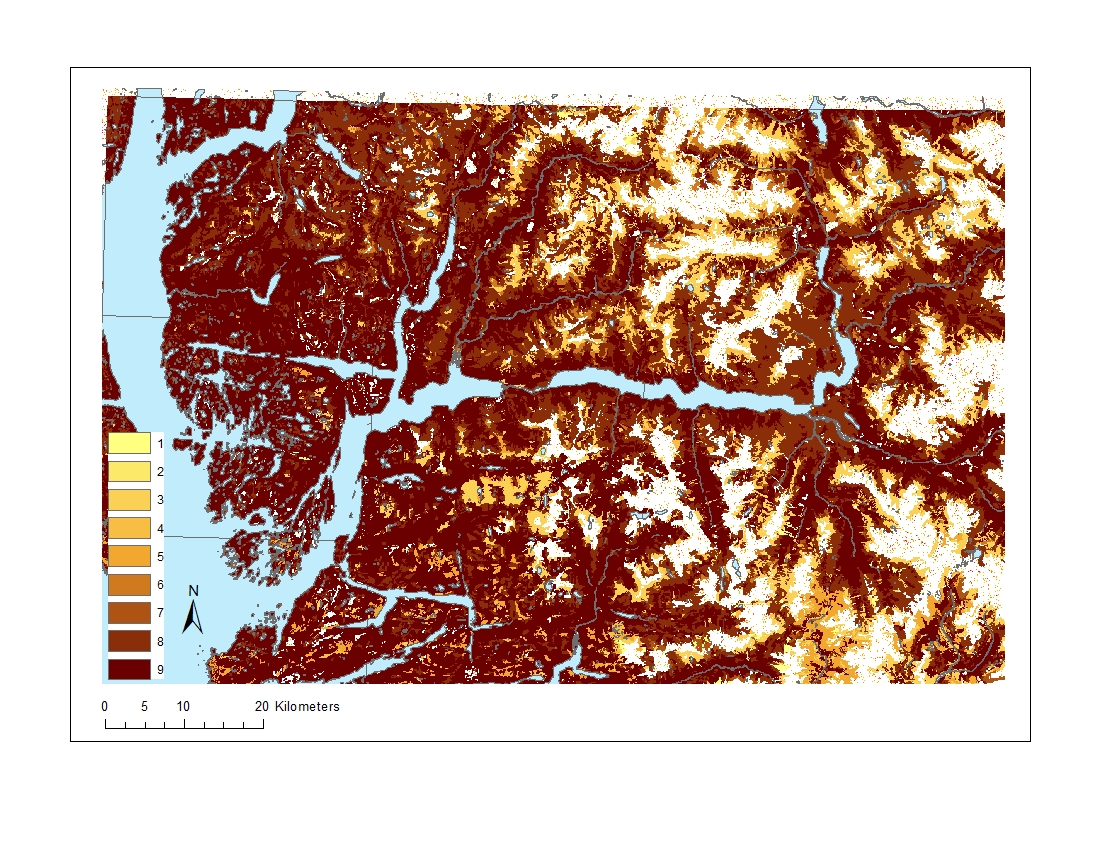Discussion of Factors
Choosing appropriate factors and constraints are an integral part of successful multi-criteria analysis. It is important to choose factors that are operational, minimal and not redundant. Often times, in choosing a factor, the corresponding data may be ineffective for the chosen outcome. This is often dependent on the mandate of the data collection.
A perfect example of this was present in my own MCE process. I originally intended to include tree cover pattern as a factor in my MCE analysis because of M. fucas preference for open canopy habitat , but upon working with the data, I noticed that it was highly generalized and excluded areas that I know to be open forest in the territory. Had I spent more time with the metadata during my data collection phase, I would have noticed the mandate for this data. It was developed by the Ministry of Forests, Lands, Natural Resource Operations and Rural Development. The metadata states:
“Geospatial forest inventory dataset updated for depletions, such as harvesting, and projected annually for growth. Sample attributes in this dataset include: age, species, volume, height.The Vegetation Resources Inventory (VRI) determines both where a resource is located and how much of a given vegetation resource (for example, timber or coarse woody debris) is within an inventory unit.”
This tells me that perhaps the nuances of smaller open areas were not cared for in the collection of this data, making it inappropriate for my analysis. It was likely intended to be generalized for initial forestry planning stages, or meant for a smaller scale map of British Columbia as a whole.

Additionally, I thought to include soil moisture as a factor in my analysis, but this data had many overlapping areas with soil nutrient class D-E as well as with the Elevation and Slope data, making its inclusion in my analysis redundant and unnecessary.
Discussion of Analytical Hierarchy Process
The analytical hierarchy process tends to be the most controversial portion of the MCE. The process involves a sequence of paired factors, and the user is meant to rate one factor’s importance over it’s pair. This continues until all factors combinations have been addressed. This process is meant to sort the factors into a numerical scale of importance in relation to other factors standardized to 100%. There was no available information on the importance of one environmental factor over others, so my decisions were based off of passive ground-truthing that I had done in the Spring as well as on the range that was included in M. fusca habitat preferences (some factors had a wider range of habitat preference than others). Soil nutrients has the most importance because of its overlap with soil moisture. Aspect was given the least importance because from what I remember, there were crabapple trees on many different slope aspects throughout the territory. There is room for further research into the importance of these factors in relation to one another.
Weighted Sum
I chose to divide the weighted sum analysis into two evenly distributed categories, “unlikely habitat,” and “likely habitat.” Each category represents 50% of the weighted sum. This is a relatively broad scope of “likely habitat”, but due to the constraints of the bear monitoring sites, I felt it best to allow for error in the MCE and to follow up with ground-truthing before limiting the results further.
Sensitivity Analysis
The sensitivity analysis is arguably the most important part of a multi-criteria analysis. This is because it addresses any uncertainty present in the data used in the analysis. Conducting a sensitivity analysis in an MCE involves a redistribution of factor weights in order to determine if the analysis is subject to minor changes. In conducting my sensitivity analysis, I chose to evenly weight all of the factors. The results of this show that the analysis is subject to minor changes. My weighted sum allows for a broader distribution of potential M. fusca habitat, which I feel is welcome in this analysis. For the purposes of the future of this project, having broader potential allows for more extensive ground-truthing.
